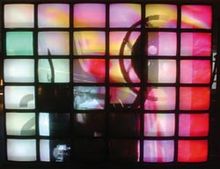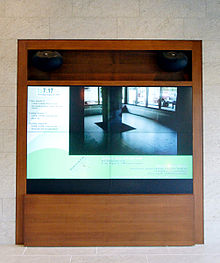- Video wall
-
A video wall consists of multiple computer monitors, video projectors, or television sets tiled together contiguously or overlapped in order to form one large screen. Typical display technologies include LCD panels, LED arrays, DLP tiles, and rear projection screens.
Screens specifically designed for use in video walls usually have narrow bezels in order to minimize mullion - the gap between active display areas - and are built with long-term serviceability in mind.[1] Such screens often contain the hardware necessary to stack similar screens together, along with connections to daisy chain power, video, and command signals between screens.[2] A command signal may, for example, power all screens in the video wall on or off, or calibrate the brightness of a single screen after bulb replacement.
Reasons for using a video wall instead of a single large screen can include the ability to customize tile layouts, greater screen area per unit cost, and greater pixel density per unit cost, due to the economics of manufacturing single screens which are unusual in shape, size, or resolution.
Video walls are sometimes found in control rooms, stadiums, and other large public venues, such as Oakland International Airport's baggage claim,[3] where patrons are expected to observe the display at long distances. Video walls can also benefit smaller venues when patrons may view the screens both up close and at a distance, respectively necessitating both high pixel density and large size. For example, the 100-inch video wall located in the main lobby of the Lafayette Library and Learning Center has enough size for the distant passerby to view photos while also providing the nearby observer enough resolution to read about upcoming events.[4]
Simple video walls can be driven from multi-monitor video cards, however more complex arrangements may require specialized video processors, specifically designed to manage and drive large video walls.[1] There is also new software-centric video wall technology that uses ordinary PCs, displays and networking equipment.[5]
Contents
Latest Advancements
Researchers around the U.S. have been advancing video wall technology in recent years.
Jason Leigh and others at the Electronic Visualization Laboratory, University of Illinois, Chicago, developed SAGE, the Scalable Adaptive Graphics Environment, allowing the seamless display of various networked applications over an LDW system. Different visualization applications such as 3D rendering, remote desktop, video streams, and 2D maps, stream their rendered pixels to a virtual high-resolution frame buffer on the LDW. Using a high-bandwidth network, remote visualization applications can feed the streams of the data into SAGE. The user interface of SAGE, which works as a separate display node, allows users to relocate and resize the visualization stream in a form of window, which can be found in a conventional graphical user interface. Depending on the location and size of the visualization stream window on the LDW, SAGE reroutes the stream to respective display nodes.[6]
Chromium is an OpenGL system for interactive rendering on graphics clusters. By providing a modified OpenGL library, Chromium can run OpenGL-based applications on a LDW with minimal or no changes. One clear advantage of Chromium is utilizing each rendering cluster and achieving high resolution visualization over a LDW. Chromium streams OpenGL commands from the `app' node to other display nodes of a LDW. The modified OpenGL library in system handles transferring OpenGL commands to necessary nodes based on their viewport and tile coordinates.[7]
David Hughes and others from SGI developed Media Fusion, an architecture designed to exploit the potential of a scalable shared memory and manage multiple visual streams of pixel data into 3D environments. It provides data management solution and interaction in immersive visualization environments. Its focus is streaming pixels across heterogeneous network over the Visual Area Network(VAN) similar to SAGE. However, it is designed for a small number of large displays. Since it relies on a relatively small resolution for the display, pixel data can be streamed under the fundamental limit of the network bandwidth.[8]
Based on video wall display technology developed at University of California, Irvine’s California Institute for Telecommunications and Information Technology (Calit2), Hiperwall, Inc. was formed to commercialize a video wall system that offers advanced software functionality and interface with standard PCs, monitors and Ethernet network.[9]
The system displays still images up to 1GB resolution or larger, HD videos, live HD video streams and PC applications. Multiple feeds can be displayed on the wall simultaneously and users can reposition and resize each feed in much the same way they move and resize windows on a PC desktop. Each feed can be scaled up for viewing on several monitors or the entire wall instantly depending upon the user’s discretion.[5]
See also
References
- ^ a b "What is a Video Wall?". http://www.pixell.com/what_is_a_vw.htm. Retrieved 2011-01-31.
- ^ "Clarity Margay II Specifications". http://www.pixell.com/margay_ii.htm. Retrieved 2011-01-31.
- ^ "Terminal 2 Baggage Claim Building Opens In July". Oakland International Travel Planner (Port of Oakland): pp. 12. 2006-. http://www.oaklandairport.com/pdf/travel_planner/september_october_2006.pdf. Retrieved 2011-02-01. "An 8-foot by 21-foot video wall featuring finished works by local artists commissioned by the Port of Oakland"
- ^ "Living Media Wall". http://www.lafayettelib.org/library/mediaWall.html. Retrieved 2011-01-31.
- ^ a b "Startup of the Week: Hiperwall". http://www.informationweek.com/news/hardware/peripherals/showArticle.jhtml?articleID=212902015.
- ^ L. Renambot, R. Rao, A.and Singh, B. Jeong, N. Krishnaprasad, V. Vishwanath, V. Chandrasekhar, N. Schwarz, A. Spale, C. Zhang, G. Goldman, J. Leigh, and A. Johnson. "Sage: the scalable adaptive graphics environment." In Proceedings of the Workshop on Advanced Collaborative Environments, September 2004.
- ^ Greg Humphreys, Mike Houston, Ren Ng, Randall Frank, Sean Ahern, Peter D. Kirchner, and James T. Klosowski. "Chromium: a stream-processing framework for interactive rendering on clusters." ACM Transactions on Graphics (TOG), 21(3):693–702, 7 2002.
- ^ D. Hughes. "Sinking in a sea of pixels - the case for media fusion." In Proceedings of Immersive Projection Technology Workshop, May 2004.
- ^ >"Startup Creates Video Wonderwall". http://www.crn.com/blogs-op-ed/applications-os/215801371/startup-creates-video-wonderwall.htm;jsessionid=Xe1Gn1+deNvz8saeLBJXzw**.ecappj02.
External links
- Penn State's High Resolution Display Wall
- Setting up a Video Wall with NMM - Using Open Source software for setting up a software-based video wall
Categories:- Display devices
- Video hardware
- User interfaces
Wikimedia Foundation. 2010.


